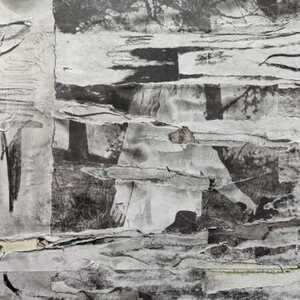Saturday Night Hay Fever
Bluegrass Artists Cover Disco Hits
Skipping Discs
At first, she was afraid. She was petrified… and, some might say, country-fried.
Her words jump crisply from the speakers, pure and unafraid. They are an unmistakable echo of one of disco’s finest hours, but with Linda Salmons’ southern belle delivery, they’ve grown daisies. “I will survive,” she says, and she means it. The classic Gloria Gaynor words have come out of a million mouths before, but most waste their time trying to capture the full soul of Gaynor’s legendary voice. Salmons has these words captured on the right end of a lasso, though. They are hers as much as they are Gaynor’s, and she reels them in with a banjo and mandolin.
It’s hard not to laugh at first. As Salmons works her way into the second verse, the music surrounding her is a far cry from the groove and groan of 1979. It is twangy and chaotic, like an earthquake at a store full of tiny guitars. Through the snickers and jokes, Salmons continues in proud dedication, and so do the short notes, the fiery guitar, the mysterious dobro. Suddenly, you realize something startling: this is real. This is serious. This is, dare I say, good!
Every single track on Saturday Night Hay Fever, a compilation of bluegrass artists covering classic disco hits, forces that same internal conflict. For most of the world, disco is something for cheesy class reunion dances, and bluegrass is the product of a creative landscaper. It is confusing to hear them meet, but it undeniably unique.
Bluegrass is a southern musical genre that clings tightly to its roots, which officially date back to the early 1940s. It is acoustic by design, and usually includes banjos, fiddles, mandolins, upright bass, and once commonly involved spoons and washboards. It is high-paced and fueled by its musicians’ technical skill, and for all intents and purposes, is the be-bop jazz of country music. Bluegrass pioneer Ricky Skaggs once told a revealing joke about how strong bluegrass artists feel about maintaining its acoustic origins: “How many bluegrass musicians does it take to change a light bulb? One, and three to complain because it’s electric.”
Saturday Night Hay Fever producer Rick Schober had no problem finding quality acts to take on the musical bell bottoms, though. From the harmonized crooning of “Night Fever” from The Blackfoot Brothers to The High Class Family Butchers’ charging rendition of “Mamma Mia” – a subdued voice instructs the players to play it “aggressively” before the track begins – this is perhaps the best that disco has sounded in decades. It’s nearly impossible to imagine anyone enthusiastic about a disco tribute album, but everything from the floating chicken on the cover to the very concept itself makes this a hard offer to ignore. Plus, whether we like them or not, we know these disco songs, and we know them well.
Bluegrass is something of a well-kept secret, but it explodes through these tunes in a format as old as it is fresh. It has breathed life into these tired classics, and in the process, the bluegrass has catapulted itself into something it had not been before: recognizable.
This is what should happen to good songs when they die. They shouldn’t just go to heaven; nay, they should be reborn.
Skipping Discs: http://www.skippingdiscs.com












